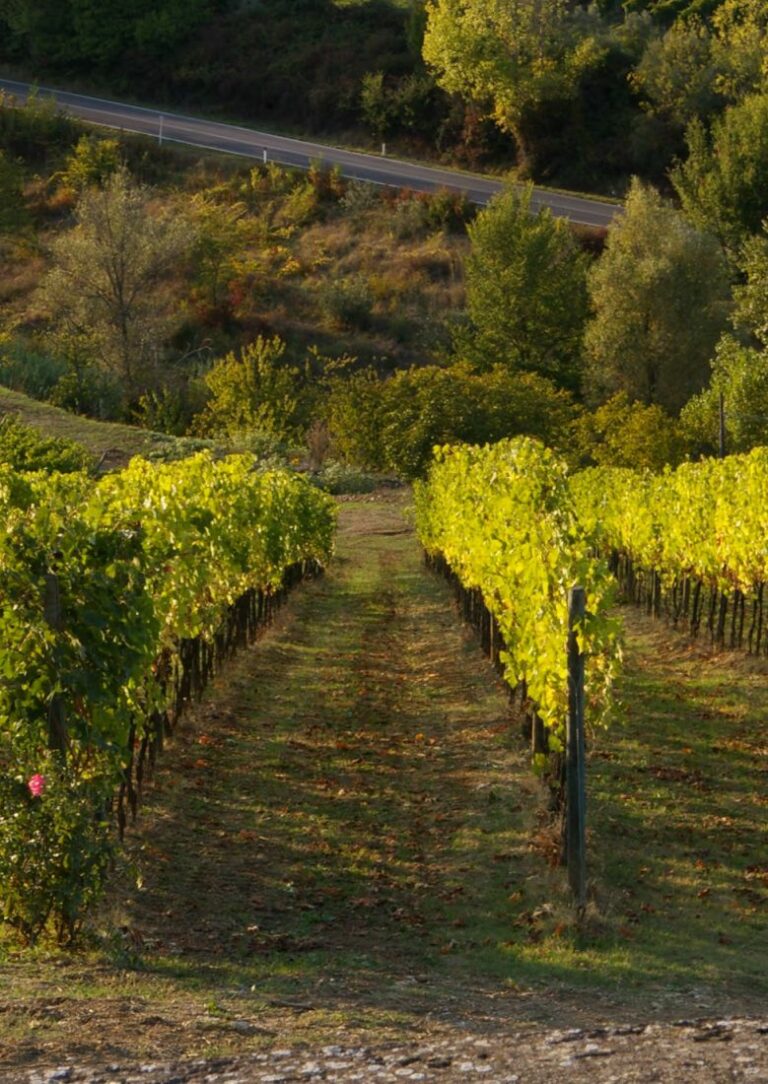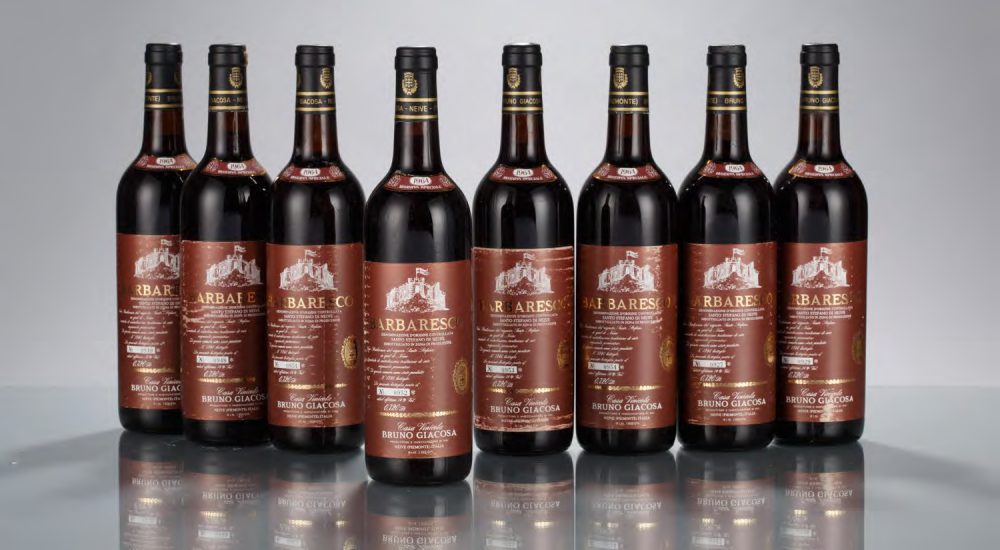We at Asia Bankers Club along with our partner, Cult Wines, are always striving to diversify the investment portfolios of our members, if you’d like to learn more about wine investment recommendations, its growth and ROI, please contact us now and we’d be happy to assist further.
Contents
- Barolo & Barbaresco Producers, Piedmont
- Bartolo Mascarello
Bartolo Mascarello, Barolo
- Giuseppe Rinaldi
Giuseppe Rinaldi, Barolo Brunate
- Bruno Giacosa
Bruno Giacosa, Falletto Vigna Le Rocche Barolo Riserva
Bruno Giacosa, Barolo Vigna Rocche Riserva (Red Label)
- Gaja
Gaja, Barbaresco
- Giacomo Conterno
Giacomo Conterno, Barolo Riserva Monfortino
Giacomo Conterno, Barolo Cascina Francia
- Tuscany Producers
- Tua Rita
Tua Rita, Redigaffi
- Antinori Family
Tignanello
Solaia
- Sassicaia
- Ornellaia & Masseto
Ornellaia
Masseto
Bartolo Mascarello
History
Founded in 1918 when Giulio Mascarello returned from the First World War to find the Society of Barolo to be in a parlous state. So much so that he decided to become an independent wine producer slowly acquiring parcels of wines in the best vineyards of Cannubi, San Lorenzo, Rue and Rocche del Annunziata (la Morra).
Bartolo, Giulio’s son further enhanced the reputation and was a towering presence ins Barolo for over 50 years before passing in 2005. His daughter, Maria-Teresa, is now at the helm and, like her father and grandfather before her, is a staunch traditionalist making as good, if not better wines than her father. Their wines are considered as good as any produced in Barolo.
This tiny 5 -hectare Domaine lies in the Barolo village and although they do make single vineyard wines (in selective years) they prefer to blend across all four vineyards to make a straight Barolo. At the time single vineyard bottling was becoming more popular, as was the custom in France, but Giulio resisted this trend, remaining faithful to the traditional method of blending, in order to ensure a wine of more balanced proportions.
Mascarello’s Barolo frequently wins plaudits from the leading critics with Antonio Galloni of Vinous Media awarding the 2010 the perfect 100-point score. Other great vintages produced include the 2015, 2013, 2008, 2007, 2006, 2001 and the 1997. The wines are long-lived with notable vintages from the 1960s still drinking very well. Production is tiny with about 1,250 cases
made per annum.
Market Performance
- Top 3 performing vintages returned an average of +282% over the last five years
- Average 2-year performance across vintages from 2003 to 2014: +56.3%
- Average RobertParker ‘s Wine Advocate score across all vintages since 2003 – 95 points
Bartolo Mascarello, Barolo – Key Vintage Five-Year Performance
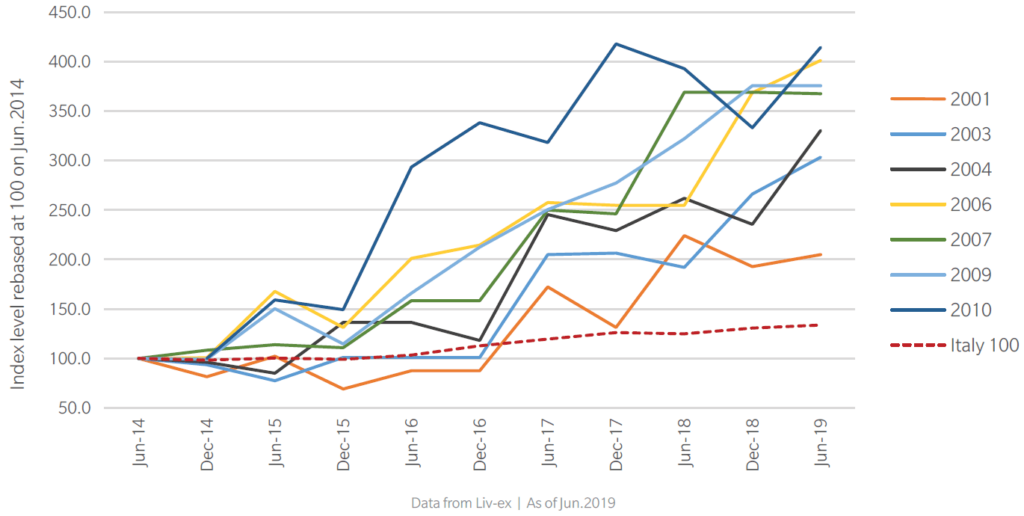

Giuseppe Rinaldi
History
Giuseppe Rinaldi was a legendary and often controversial figure in Langhe who sadly passed away in 2018. Rinaldi’s wines are revered by those in the know. His wines are made in the most traditional Barolo style; powerful, austere, long maturing and without any compromise to modern-day trends. In fact, his philosophy was to make wines that weren’t easily pleasing but far more intellectually challenging.
Like many traditionalists, he prefers to blend across the different vineyards citing “This is how the previous generations obtained a natural balance and harmony in Barolo, and, for me, it is still the perfect method.”. He’d previously taken over from his father, Battista who had passed away in 1992 and to this day it is still a family-owned estate. Due to the near-mythical status of his wines, prices appreciated sharply after his death and the wines are also very sought after at auction.
The estate produces 38,000 bottles per year across their two Grand Cru vineyards; Brunate & Cannubi-San Lorenzo, their Tre-Tine Barolo and a number of other village wines. His Barolo Brunate (a blend of the two famous single vineyards; Brunate & Le Coste) is arguably his flagship wine produced for the first time in 1993. Prices can range from £2,000 to £6,000 per 12, depending on the vintage. In 2010 Antonio Galloni of Vinous Media awarded it 100 points. Production is tiny at 850 cases per year.
Market Performance
- Best performing vintages 2006 with 5-year total return of + 281.5%
- Average 2-year performance of vintages from 2000 to 2012 + 51%
- Average score across all vintages of Barolo Brunate since 2000 – 94.5 points
Giuseppe Rinaldi, Barolo Brunate – Selected vintages performance
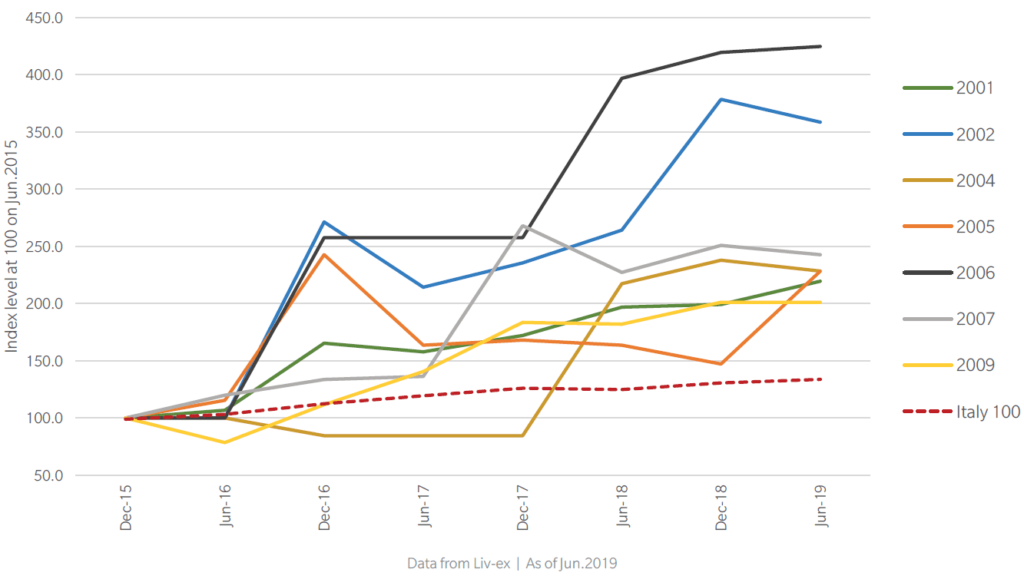

Bruno Giacosa
“If I were restricted to only one bottle of Italian wine, it would be one of the great Barbarescos or Barolos from Bruno Giacosa” – Robert Parker
History
Bruno Giacosa is regarded as one of, if not, the greatest winemakers in Barolo. He sadly passed away in 2018 aged 88 and will be remembered for transforming the region. His wines became a by-word for Barolo to a new generation of Italian wine consumers. A pioneer, a perfectionist and a true Piedmontese; Bruno worked from the age of 13 with his father and grandfather in the family cellar. Giacosa is one of the main reasons that Barolo and Barbaresco have become household names and many of his wines (and wines from other producers of the region) can rival their counterparts from Europe. For many, a Giacosa red label Riserva, only produced in vintages deemed of exceptional quality, is the equal of any great red wine made in the world.
The current wine making team consists of Bruno’s daughter Bruna alongside oenologist Dante Scaglione, who worked closely with Bruno for many years before returning to help the family in 2011.
Today, Bruno Giacosa’s estate covers 20 hectares of vineyards. The key wines are:
- Falletto di Bruno Giacosa ‘Riserva – Falleto Vigna Le Rocche’ Barolo DOCG (red label)
- Falletto di Bruno Giacosa Asili Riserva, Barbaresco DOCGBarbaresco D
- Falletto di Bruno Giacosa ‘Falletto’, Barolo DOCG
- Bruno Giacosa Albesani Santo Stefano, Barbaresco DOCG
- Falletto di Bruno Giacosa Asili, Barbaresco DOCG
- Falletto di Bruno Giacosa Rabaja, Barbaresco DOCG
- Bruno Giacosa Collina Rionda, Barolo DOCG
Focus – Bruno Giacosa, Falletto Vigna Le Rocche Barolo Riserva
- Precision and quality:
- Giacosa will only make Riserva (red label) when the wine meets his scrutinous quality standards.
- Only 11 vintages have been made of Riserva since 1989 (89, 90, 96, 00, 01, 04, 07, 08, 11, 12, 14).
- Death effect:
- Bruno Giacosa passed away in 2018 – although there is succession with his daughter Bruna in charge, the wines he made have become even more desirable.
- 2012 was the last vintage of Riserva made under Bruno Giacosa.
- Miniscule production:
- Tiny volumes are produced for his Riservas (red labels).
- < 1000 cases.
- Brand:
- Prices and demand are on an upward trajectory for the top Barolo producers.
- Ranking 56th in the Liv-Ex Power 100 list 2018, a rise of 76 places from 132nd in 2017.
Market Performance – Barolo Vigna Rocche Riserva (Red Label)
- Best performing vintage 2004 returned +215.4% over the last five years
- Average 2-year performance across vintages since 2001 +37.9%
- Wine Advocate cores of last 3 vintages, 2011, 2012 and 2014 are 97,96 and 97 points
Bruno Giacosa, Barolo Vigna Rocche Riserva (Red Label) – Vintage performance
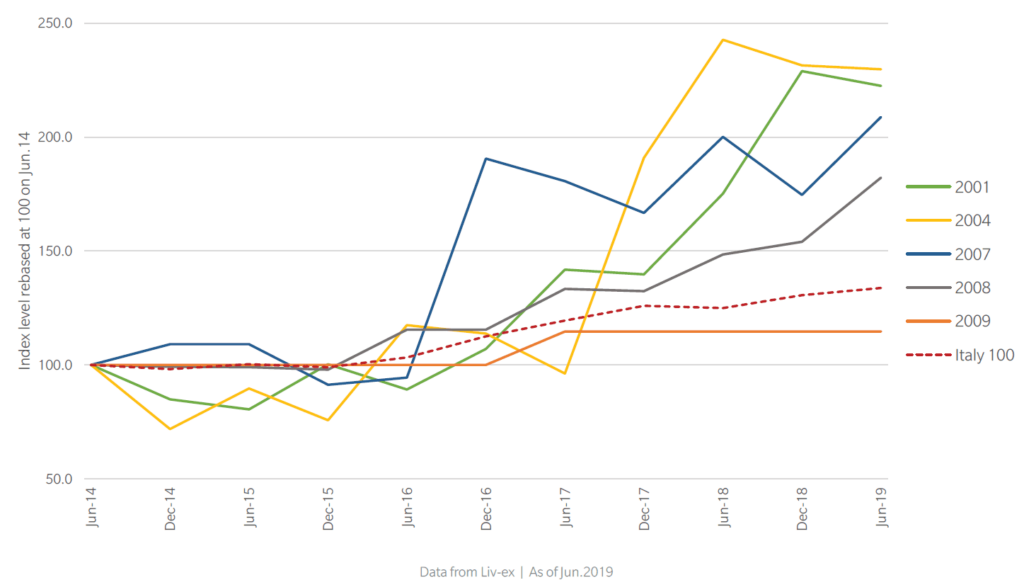

Gaja
History
Angelo Gaja needs little introduction as one of Italy’s most influential and revered wine makers. His impact on Italy’s fine wine market over the last 20 years cannot be underestimated. One of the legends of the wine industry, Gaja has been credited with transforming not just the reputation of Piedmonte wine, but of Italian wine altogether, having had a significant impact on the way Italian wine is grown, priced and marketed.
His wines are rich, opulent and age-worthy – they are also incredibly well received by the major critics, frequently scoring 95+ points. Whilst Gaja traditionally produced wines from the Barolo and Barbaresco DOCGs he later diversified into Tuscany, specifically Brunello di Montalcino. His meticulous nature and uncompromising approach to quality famously meant that he refused to sell 12,000 cases of his 1984 Barbaresco under the Gaja label as the quality was not there, instead he sold it off in bulk. Interestingly, his 1985 Barbarescos were (proclaimed by the Wine Spectator) as the “finest wines made in Italy”.
Gaja is one of the most successful marketing machines, in the most affectionate way possible, in the wine world. They produce the greatest wines in Italy and believe that the consumer needs to be prepared to pay accordingly. The brand was the first ranked Italian wine in Liv-ex’s Power 100 list 2018, and their flagship wines have been labelled the “unofficial First Growths of Northern Italy’.
Gaja is one of a handful of brands that can compete with and charge the same prices as the top names of Burgundy and Bordeaux. Nethertheless, the top wines are available at a fraction of the price of their French counterparts and have all the credentials to create a following similar to that of the top end Burgundy producers. Heritage, personality and quality shine through in these wines and they boast a level of complexity that most top Burgundy producers would be proud to call their own.
Focus
As buyers have become more sophisticated in Hong Kong and some areas of mainland China, we are at the beginning of an exciting phase for the Gaja wines. Curiously, 嘉雅 (Gaja) is interpreted as precious and elegant according to Chinese characters and the growing number of tasters in Asia. This is very important for wine brands in Asia – the connection or perception for consumers has a massive impact on demand. Today, Gaja Gaja overseas the day-to-day running of her family’s iconic vineyards. The leading wines are:
Barbaresco:
- Gaja Barbaresco DOCG
- Costa Russi
- Sori Tildin
- Sori San Lorenzo
Barolo:
- Sperss
- Contiesa
- Dragromis
Whilst we believe that prices of Gaja will increase across the board, our focus is on Gaja’s single vineyard Barolo Vineyard (Sperss) and their Barbaresco. As has been demonstrated previously with the second wines of the First Growths, where the driving force behind these wines has been brand sentiment, particularly in Asia. For some, the three flagship single vineyards wines of Gaja may be out of their price range but by buying into Gaja’s other wines they are still able to access the brand. The only difference here is there seems to be little discernible difference in quality, yet they trade a roughly half the price. This disparity will surely close as the Gaja brand continues to build across the globe.
This brand momentum has further been recognised with Gaja moving up 30 places to 26th in the Liv-Ex’s Power 100 2018.
The table below illustrates the average 12 bottle case price of Gaja’s Sperss and Barbaresco and the average wine score across all available vintages since 2000, compared to the average case price and score across the three, leading single Barbaresco vineyards.


Market Performance – Gaja Barbaresco
- Best performing vintage 2006 gained a 5-year return of 119%
- Average 5-year performance across vintages since 2001 + 50%
- Average Robert Parker’s Wine Advocate score of vintages since 2003 – 93.4 points
Gaja Barbaresco – Vintage Performance since 2014
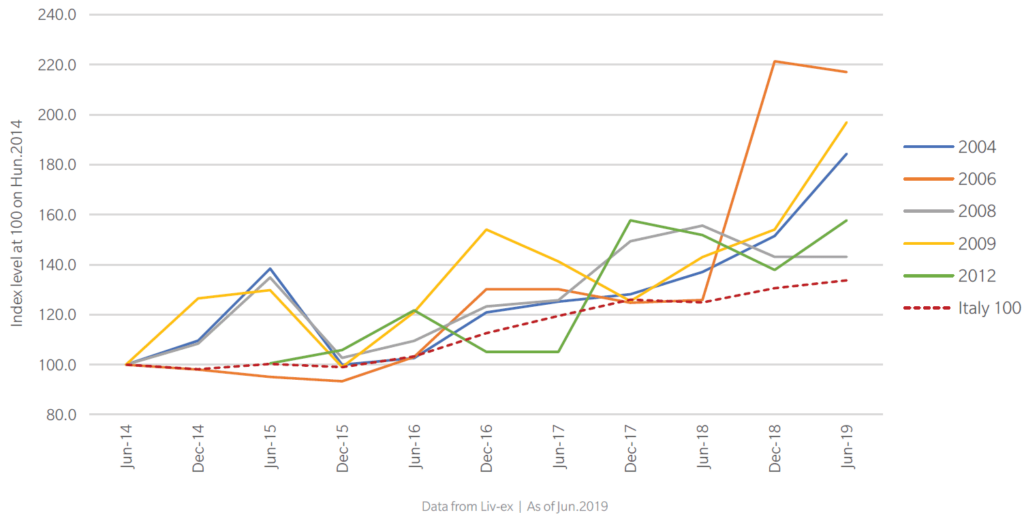

Giacomo Conterno
History
Giacomo Conterno wines first began outside Monforte d’Alba when Giovanni Conterno opened a small tavern, producing Barolo to supply his patrons. His eponymous son Giacomo, taking over from his father upon returning from World War 1, helped mould the business into one of the great estates of the region.
Considered one of the first Barolo producers to bottle their own wine, Conterno helped create what was considered an early drinking wine sold by the cask into the incredibly age worthy ‘king of wines’ we now know.
Giacomo’s sons, Giovanni and Aldo, both inherited the estate from their father but after less than a decade, and in rock-star like fashion, parted over artistic differences, with Aldo branching off to create Poderi Aldo Conterno in 1969.
Giovanni’s son, Roberto, is now at the helm and the family have continued to make viticultural acquisitions in the area, including the iconic Cascina Francia vineyard and a parcel in Cerretta. The style remains very true to its roots, with long maceration periods and large oak barrels producing a traditional, earthy and long-lived style of Barolo.
Very much like Burgundy, these are exclusive, ephemeral and incredibly rare terroir driven wines- with continually rising prices in the aforementioned, Barolo is increasingly being sought after by enthusiasts to emulate its thrill.
Focus: Barolo Riserva Monfortino
Although produced prior to, 1924 was the first commercial release of the Riserva Monfortino. A wine made only in exceptional vintages, it is aged for at least 7 years in large oak botti to soften the fearsome tannins and add layers of complexity. It is made in tiny quantities and considered one of the finest expressions of Nebbiolo in the world.
Production: 580 cases
Market Performance
- The top 3 performing vintage returned an average of +159% over the last five years
- Average 2-year performance across vintages since 2000 +39%
- Average 5-year performance across vintages since 2000 +129%
Barolo Riserva Monfortino – Key vintage 5-Year performance % since 2014
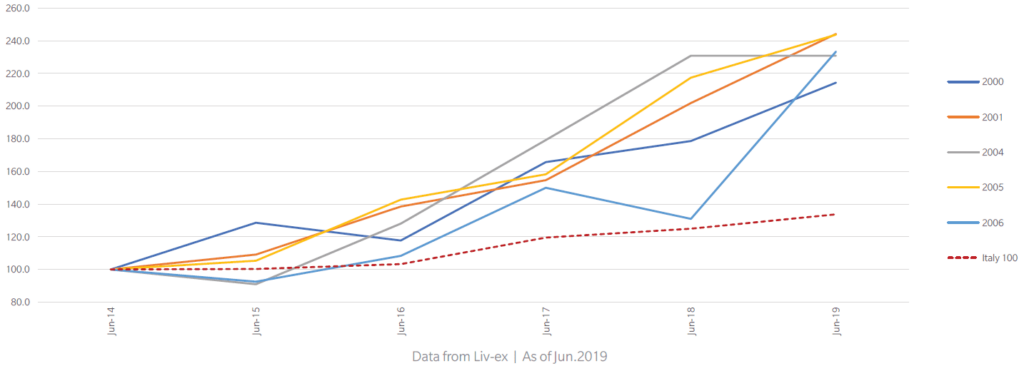

Focus: Barolo Cascina Francia
Made only in high quality vintages, Cascina Francia was purchased by the Conterno family in 1974 as more growers also became wine bottlers. This ensured a consistent supply of high quality grapes. Although an outstanding wine within its own right, it is perhaps easiest thought of as the little brother to the Riserva Monfortino, spending at least four years ageing in botti and with production levels that aren’t a great deal higher.
Production: 1,800 cases
Market Performance
- The top 3 performing vintages returned an average of + 150% over the last five years
- Average 2-year performance across vintages since 2001 + 32%
- Average 5-year performance across vintages since 2001 + 116%
Barolo Cascina Francia- Key vintage 5-Year performance % since 2014
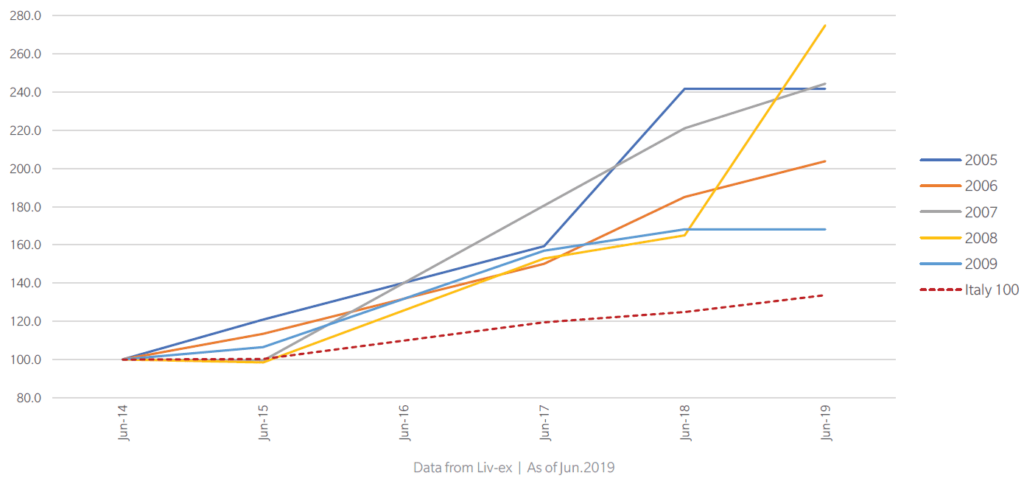

Tua Rita
History
This Tuscan estate of around 55 acres was acquired by owners Rita Tua and her husband, Virgilio Bisti in 1984. They set about planting a mixture of Cabernet and Merlot and in 1992 produced their very first vintage. It wasn’t too long after; that the estate started receiving praise and highly deserved accolades from the world’s leading wine critics and enthusiasts alike.
Its 100% Merlot offering – Redigaffi – quickly gained a cult-like status which was cemented when the world’s pre-eminent wine critic Robert Parker Jr. awarded their 2000 vintage with a perfect score of 100 points.
Setting out to produce wines simply by working the land in a natural way, they have been able to maintain the perfect terroir for grapes – Merlot being its beating heart – this is a super Tuscan not to be missed. The landscape and buildings on this property were a mere setting for living in contact with nature whilst farming their beloved land.
Tua Rita is located in Suvereto, a small medieval town in the Tuscan province of Livorno, on the gorgeous coast south of Bolgheri. The winery lies at just 300 feet above sea level, on clay, silty soil
With the estate’s other offers equally high in quality, it is of no surprise that the wines of Tua Rita are some of the most difficult to find. Especially when you consider the estate’s total annual production is currently just 3400 cases, of which only 9,000 bottles are made of the highly regarded Redigaffi. Last year Tua Rita was ranked number 96 of the Liv-Ex’s Power 100 2018, up 73 ranks from one year before.
Market Performance
- Best performing vintage 2010 of Tua Rita, Redigaffi returned +67% over 5y
- Average 5-year performance across vintages from 2003 to 2011 +16%
- Average Robert Parker’s Wine Advocate score across all vintages since 2001 – 95.3 points
Tua Rita, Redigaffi: 01-10 Vintage performance
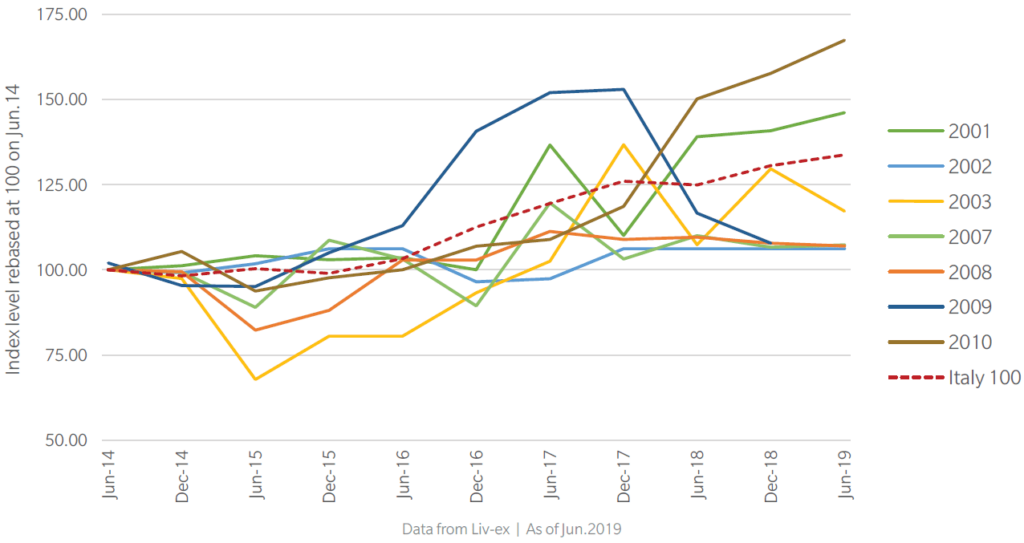

Antinori Family
History
The sunniest part of the Tignanello estate’s hillside is home to the Solaia vineyard. The word Solaia translates laxly as ‘The sunny one’, suitably named to reflect the sun-drenched location of the vineyards.
The Antinori family summarise Solaia with the following “The very best grapes from the very best vineyard. All the rest is passion, the utmost care and research. These are the secrets of Solaia together with the finest Cabernet Sauvignon, Cabernet Franc and Sangiovese grapes from its namesake vineyard.”
The eponymous wine was released in 1978 as an 80% Cabernet Sauvignon, 20% Cabernet Franc blend, following excess production of Cabernet from neighbouring vineyard, Tignanello.
A decision was made to use the additional grapes to produce 3,600 bottles of the wine that in turn became known as Solaia. Today the annual production totals 55,000 bottles, less than 5000 cases.
Solaia 2015 is critically acclaimed as one of the greatest Italian wines ever produced, receiving 100 points ratings from both the Wine Advocate and James Suckling. Monica Larner was effusive with her praise “There is a magical infinity, a continuous loop of compatibilities, between the icon wines of Tuscany and the 2015 vintage. The stunning 2015 Solaia is solid evidence of this perfect alignment”. Other standout vintages are 2010 & 2007.
Focus: Tignanello
The wine which led the way for the Super-Tuscan movement which swept the world before it; the evolution of Tignanello represents a number of historic innovations for Italian wine: the first Sangiovese to be aged in French-style barriques, the first abandonment of the mandatory portion of white grapes in a Tuscan red wine blend and the first wine to adopt the non-native Cabernet Sauvignon. From 1971 to this day, Tignanello is 85% Sangiovese, with Cabernet varieties making up the remainder. It is a warm, velvety and inviting wine with an opulent palate that often boasts black cherries, spices, vanilla and tobacco, and smooth, silky tannins.
Renzo Cotarello, CEO and chief winemaker of Antinori, has pointed out that the same eight vintages of Tignanello and Solaia: 1997, 1999, 2001, 2005, 2007, 2010, 2011 and 2013 stood out on quality. ‘These vintages represent our stylistic path of the last 20 years,’ says Cotarella.
Market Performance
- Top 3 performing vintages 2003,2004 and 2005 returned an average of +177.5% since release
- Average 5-year performance across vintages from 2003 to 2011 +58%
- Average Robert Parker’s Wine Advocate score across all vintages since 2003 – 94 points
Tignanello – Market Performance
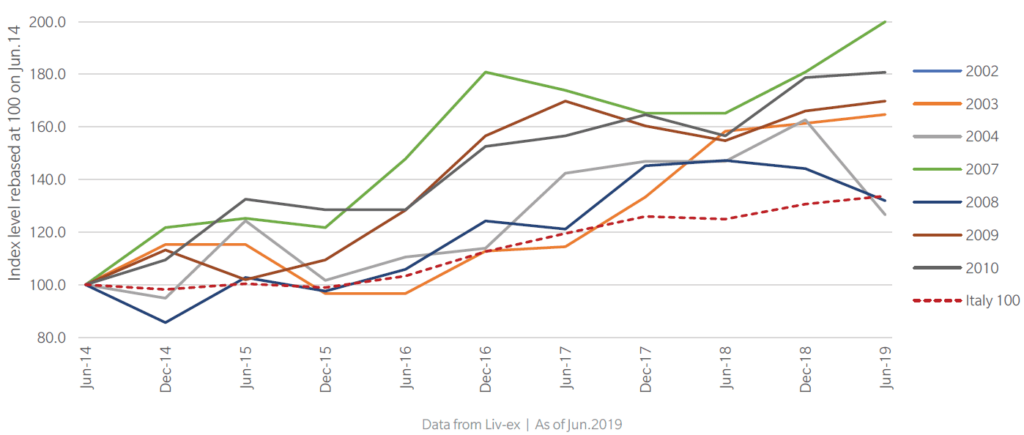

Focus: Solaia
With a name that reflects its sunny microclimate, this wine is produced in far smaller quantities than older brother Tignanello (under 10 hectares of vines in origin). Limited supply and single-origin are the factors that combine here to make Solaia the most prestigious wine within the sprawling Antinori stable, with prices regularly on a par with Bordeaux First Growths. The first vintage was 1978 though there hasn’t been a Solaia every year since then. The 2015 release has been tipped to be the ‘perfect Solaia’, achieving a score of 100 points.
Market Performance
- Best performing vintages 2005 returned 132.5% over the last five years
- Average 5-year performance across vintages from 2002 to 2011 +67.3%
- Average Robert Parker’s Wine Advocate score across all vintages since 2003 – 95.1 points
Solaia – 02-09 Vintage Performance
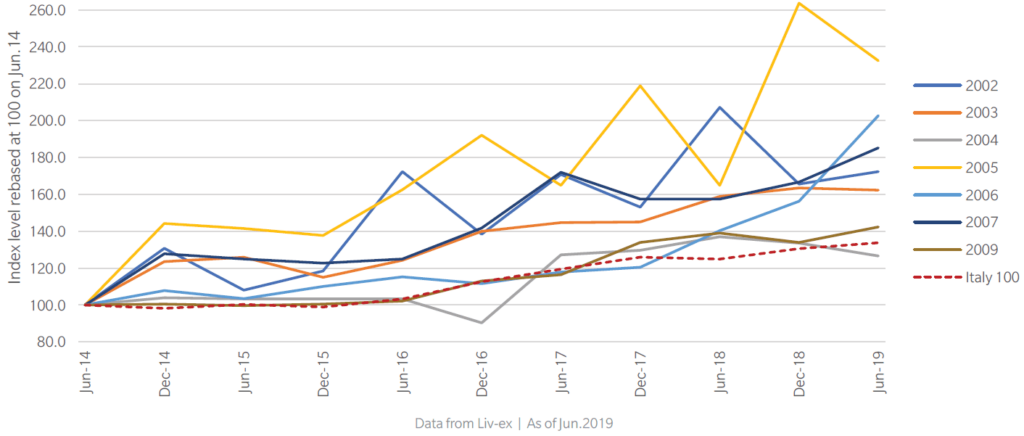

Sassicaia
History
Sassicaia is the other original ‘Super Tuscan’ as one of the first Italian reds made in the image of fine red Bordeaux, with its first small commercial vintages being released in the mid-1970s. In 1994 it became the first Italian estate to have its own DOC (having been a vino da tavola) and effectively transformed Bolgheri into an exciting and dynamic fine wine region. Never less than sensational, Sassicaia is one of the world’s greatest wines and is an extraordinarily elegant expression blend of Tenuta San Guido’s finest Cabernet Sauvignon (85%) and Cabernet Franc (15%).
With a terroir reminiscent that of the Graves region in Bordeaux, with gravelly topsoil and loam, the grand vin of Tenuta San Guido is quite reminiscent of Left-Bank Bordeaux on first meeting. Many critics have likened its style to that of the top-quality Margaux estates, though with a fresh and balanced citrus acidity on the finish that reveals its Italian origin.
Despite its best reputation amongst peers, Sassicaia has had a rollercoaster ride in terms of scores from Robert Parker from vintage to vintage over the last 10 years (with 2010 scoring a low 91) and this didn’t seem to affect demand. Furthermore, there has been a gradual improvement in the quality of the wine. The latest 2016 vintage, which was awarded the magic 100 points by Robert Parker’s Wine Advocate, generated very strong interest amongst wine collectors.
Parker Scores of Sassicaia 1997-2016
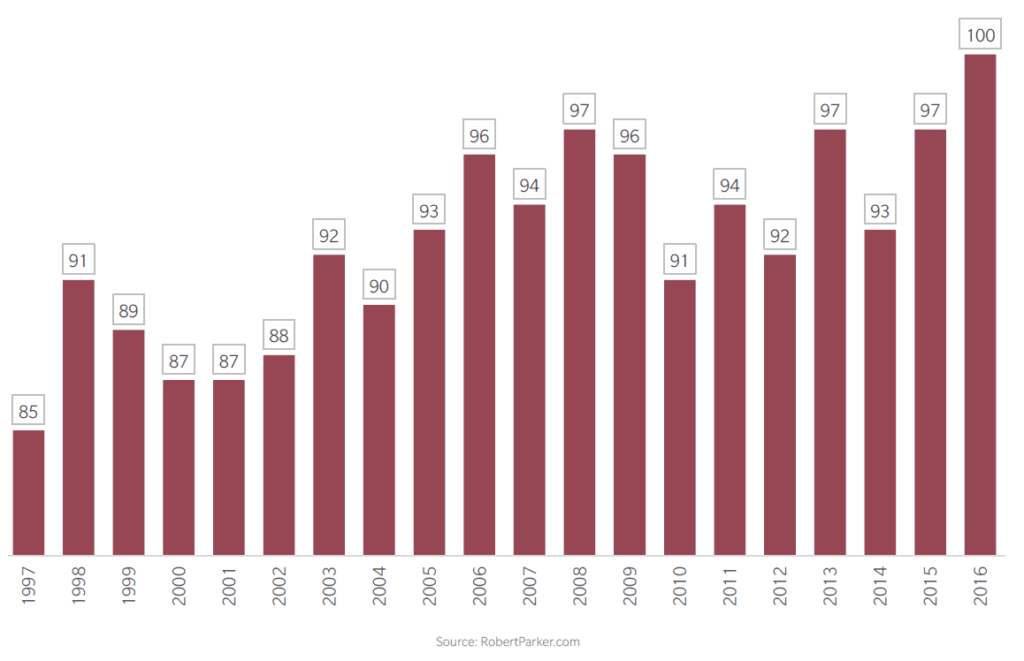

Market Performance
- Sassicaia 2015 price has increased 44.2% since it first started trading in Feb. 2018
- Average 5-year performance across vintages from 2002 to 2011 + 39%
- Average Robert Parker’s Wine Advocate score across all vintages since 2003 – 94.5 points
Sassicaia – Vintage Performance
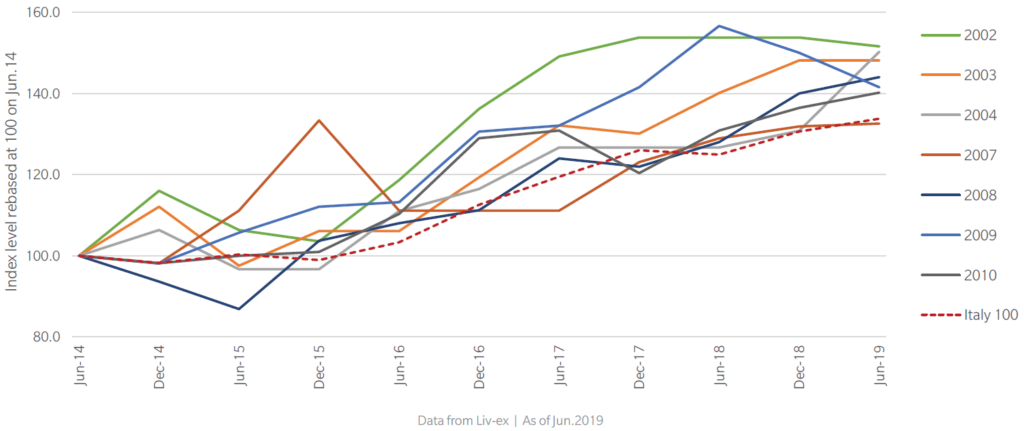

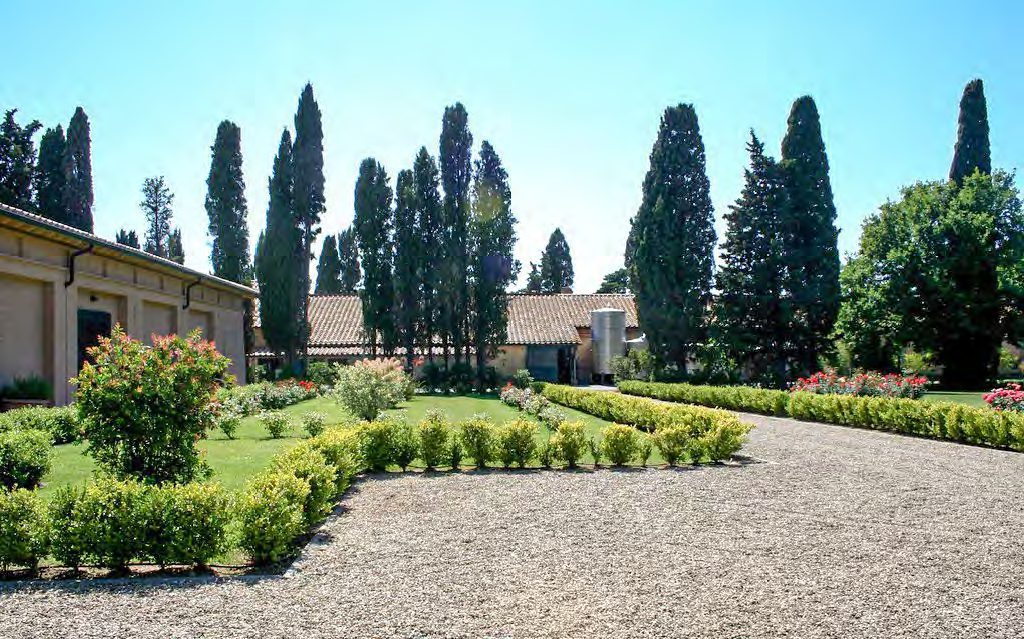

Ornellaia & Masseto
History
‘Super Tuscans’ as we refer to them now, found their roots in Tuscany’s coastal region of Bolgheri in the 1970s, and began with three key estates: Sassicaia, the brainchild of Nicolo Sassicaia, Piero Antinori’s wine Solaia and his brother, Lodovico Antinori’s estate, Ornellaia. This part of coastal Tuscany suited Bordeaux varietals such as Cabernet Sauvignon and Merlot exceptionally
well, and whilst the wine was originally made to marry native Sangiovese with these grapes for the sheer enjoyment, they soon evolved into very serious, renowned wines in their own right- so much so that a new DOC was specifically created for Bolgheri in 1994.
Michel Rolland, the world most famous oenologist consultant. was hired as early as 1991 and remain involved to this day. In 2002, Ornellaia was acquired in partnership by the famous Californian wine maker Robert Mondavi and the Frescobaldi family in 2002, with both doing much to improve the estate’s reputation. The Frescobaldi family subsequently acquired full
ownership of the estate in 2005.
Ornellaia produces two famous wines. The eponymous flagship Ornellaia, made from the four main Bordeaux varietals, is considered to be perhaps the best facsimile for great Bordeaux in Italy. Masseto, their most prestigious wine, was produced in order to replicate the great Pomerol in the region and is frequently likened in style to Petrus due to its 100% Merlot
composition.
Both wines were created in the 1980s under Lodovico Antinori but the similarities stop there. Masseto has since emerged as completely separate concept to Ornellaia, largely because of its clay soils, which aren’t ideal for either Cabernets. Masseto has its own unique identity and since its first vintage in 1987 has justified its stratospheric price tag.
These are two of Italy’s most famous, sought after and revered wines, with both achieving scores in the high 90s from major critics vintage after vintage. Masseto was also given the perfect 100 from the Wine Advocate in 2006, 2015 and 2016.
Focus: Ornellaia
Made from Cabernet Sauvignon, Merlot, Cabernet Franc and Petit Verdot, Ornellaia’s nominative offering is grown on a hillside in coastal Tuscan- the cooling maritime breezes are what give the wine its Bordeaux-esque subtlety, whilst it’s marine, alluvial and volcanic soil create something entirely unique to the terroir. The average annual production is 12,000 cases.
Market Performance
- Best performing vintages 2010 returned 42% in the past five years
- Average 5-year performance across vintages between 2000 and 2010 + 27%
- Average Robert Parker’s Wine Advocate score of vintages since 2001 – 95 points
Ornellaia – Vintage Performance
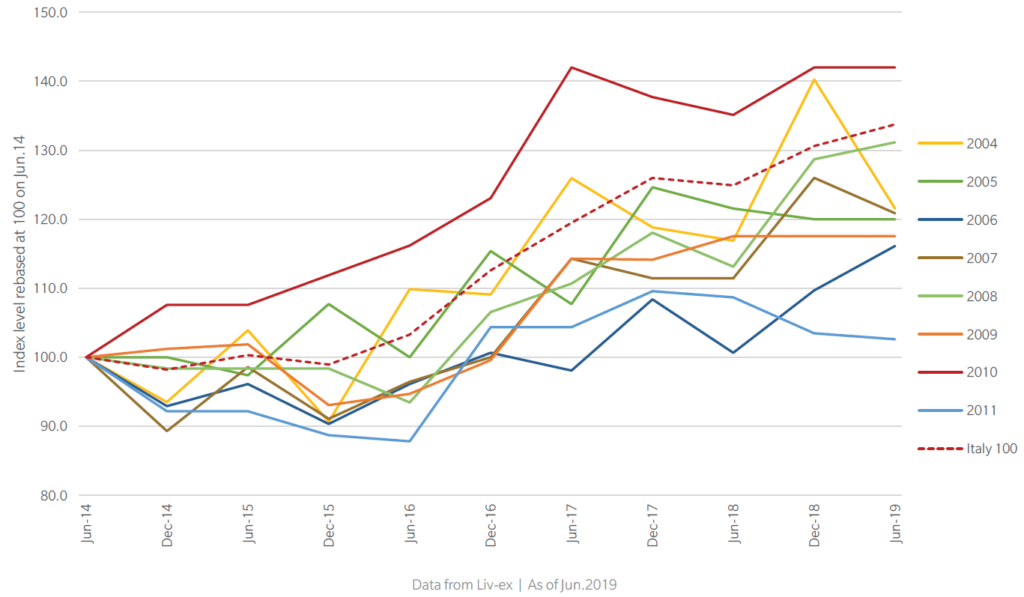

Focus: Masseto
First produced in 1987, Masseto’s reputation has been building rapidly in the last decade and earlier this year it unveiled its brand-new winery, dedicated solely to its production. It is unquestionably Italy’s finest expression of Merlot and produced in quantities similar to Pomerol Petrus. With its recent run of perfect scores and new winery, it is something we will be following even more closely. The average annual production is 2,500 cases.
Market Performance
- Best performing vintage 2006 gained a 5-year return of 40%
- Average 5-year performance across vintages since 2004 +22%
- Average Robert Parker’s Wine Advocate score of all vintages since 2002 – 96.1 points
Masseto – Vintage performance
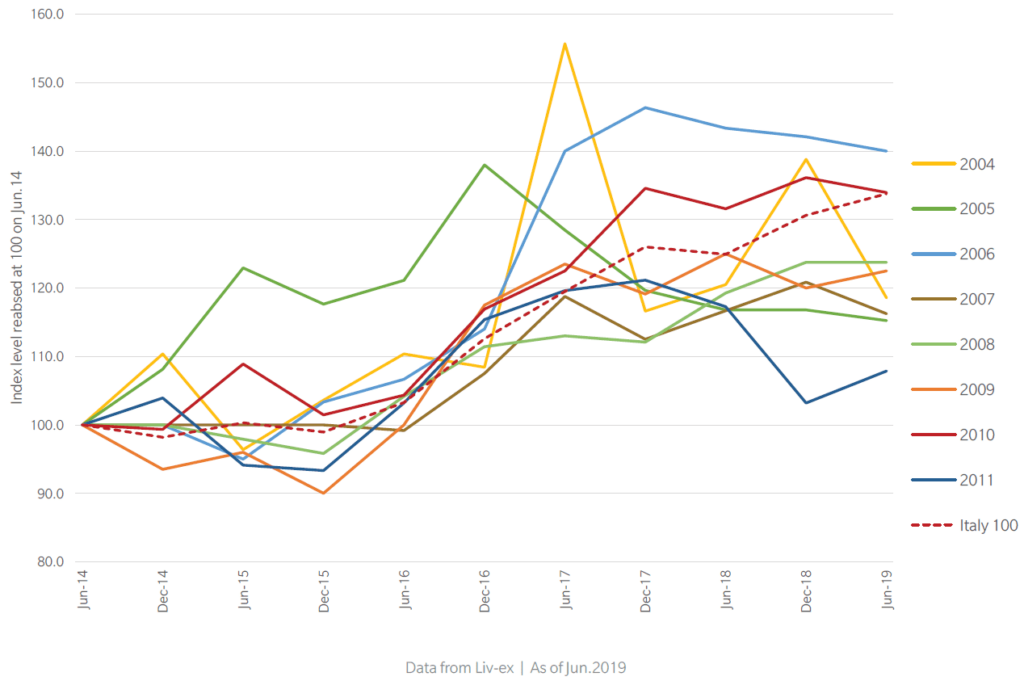

We at Asia Bankers Club along with our partner, Cult Wines, are always striving to diversify the investment portfolios of our members, if you’d like to learn more about wine investment recommendations, its growth and ROI, please contact us now and we’d be happy to assist further.
